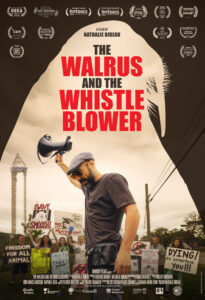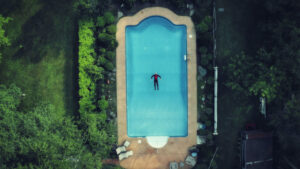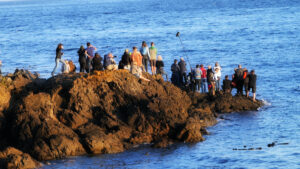Interview with “The Walrus and the Whistleblower” Director Nathalie Bibeau
Written by: Adam Vaughn | March 4th, 2021

I recently interviewed director Nathalie Bibeau, whose documentary The Walrus and the Whistleblower (which I previously reviewed) follows the journey of a former Marineland employee, Phil Demers, as he risks his career and emotional sanity to dedicate his energy and time to save the animals, specifically a friendly walrus named “Smoochie,” from the alleged abuse that occurred at Marineland during his tenure. The story had a special connection to director Bibeau, who grew up in the Niagara region of Canada and knows the area (including Marineland) well. Below is a transcript of our conversation, edited for clarity.
Adam Vaughn: How did you first learn about the tragedies at Marineland, and what was your initial reaction when you found out about everything that was going on?

Nathalie Bibeau: Well I grew up in the Niagara region, so I was a little girl who went to Marineland as a kid, and have very happy memories of my parents taking me there. As for most kids in the region, it was a bit of a rite of passage; it was something you had to do in the summer, with your family or with your school. And then I left the region and moved to Europe, and eventually back to Canada, and lived in many places around the world. And it was in 2012 … I mean there were rumors going around before that “things may not be what they seem at Marineland,” but no one had really come out with any clear facts that were available in the mainstream. Until a series of former employees came out in 2012 and made allegations.
And so that’s when I got my first serious wind of some of the things that were going on. And I was keenly interested in one of those particular stories of one of those trainers, a guy named Phil Demers, who I knew as a kid growing up, because he was a friend of my brothers. So I had this prior experience with Marineland (happy memories!) and then memories of Phil as this “s***-disturber” kid, who really wasn’t going anywhere with his life, and ends up working at Marineland for over 10 years, becomes a poster child for the organization, and then all of a sudden does this flip in the public eye and starts to make these allegations. So I started to look at it more closely, but it wasn’t until years later that I decided to make a movie about it.
AV: Could you talk a little bit more about your experience learning about the story that Phil had to tell? You mentioned you knew him growing up, so what was it like seeing him in this new light with this new side of him, and how passionate he was about saving the animals at Marineland?
NB: Well, Phil is a very complex guy, who has many different sides to him, and they’re not all pretty and inspiring. Some of them really reflect this resilience and this borderline obsession for the cause and what he’s trying to do, but also he has a very difficult time being by himself, which means that he has a difficult time being with other people, as well. So I knew about this because I knew his personality a little bit, and friends who we grew up with were talking to me about how he’s really doing behind the scenes and how things are tough for him and how he’s become a bit of a tragic figure. But when I approached him for this film, that was one of the things that interested me actually, was that it wasn’t a straightforward narrative of “good guy vs bad guy.”
This was a very nuanced character story that I could dig into and develop from a different point of view than a lot of the other films that exist in this space around animals in captivity. So my first contact with him was a bit awkward because we hadn’t spoken since we were teenagers. And he had become a certain type of person, and I had become a different type of person, and I lived far away at the time. And so we were feeling each other out, getting to know each other as adults again, and seeing if this could work. I was very clear with him that editorially this would be my story to tell, and that he was a character in it. And he accepted those terms. It was very important for me to keep my editorial independence and tell the story that I wanted to tell. And I have to give him credit for that, because he respected that and knew that that’s how things were going to be.

But the beginning of the filming was absolutely fascinating for me, and heartwarming, because I got to go back to my hometown, speak to people I hadn’t talked to in ages about a very controversial topic in the region, get to know this guy who I had known as a kid in a different kind of way (learn his flaws, his qualities, and everything in between) and then tell this story on my own terms, but about something that was familiar to me as a kid. Stories I had done before were more journalistic in nature, and I wanted to have a bit of a departure with this film and say something more personal, artful, soulful, always anchored in journalistic rigor, but with a bit of a polish that I hadn’t been able to do before. And so my personal connection to the story is what enabled me to do that.
AV: So with this film beginning, and as you were filming, how proactive did you end up becoming in a lot of the actions that take place during the documentary? Was there ever a time where you started to feel, as the filmmaker, that you started to play the role of an activist outside of shooting the film, or was there a sense of trying to stay detached and stay true to the art and the story, and try to keep out of what was going on? How did that balance out?
NB: It was very important for me to not become an activist while making this film, because there are different types of documentaries. There are social-issue documentaries that have a very clear cause and a narrative and goal, and I didn’t want to make that type of documentary. I wanted to tell a messy human fable about a very public topic, and to look at this not only through the eyes of the animals, but through the eyes of the humans who are in conflict about it. And I wanted to be able to look at this from a distance and see the nuances in Phil’s character and the nuances in Marineland’scharacter (even though I didn’t get access to them) but I tried to represent some of the sympathy that someone might feel for an older gentleman who runs a business successfully for 60+ years, is the “jewel of the region,” and then all of a sudden has this great fall, and there’s these negatives things that are published about him and his work, his animals, in the media. And the betrayal he must’ve felt when Phil turned and became a whistleblower, and the other employees as well.
So I tried to create these nuances, observe them, and then reflect them in the documentary, and not get caught up in Phil’s own particular cause, which I do make essential to the film because it is such an emotionally charged narrative, and makes for great storytelling. But for me it wasn’t about that, it was about unfurling what’s really going on behind the scenes in this public battle. It is a micro-small story going on in a small town, but it has bigger ramifications. We now have a law, for example, in Canada, that bans the captivity of whales and dolphins. Following that throughout the process, again very important for me to keep a distance and be in the observer seat. So that I could tell a story that weaves in and out of the greyness of the tale.

AV: I know you mentioned that some of the members of Marineland weren’t in contact or weren’t willing to speak on camera. Were there any other people that you wanted to interview, or in general other obstacles that you faced while filming this documentary?
NB: I encountered what appeared to me as fear, on the part of a lot of people in the region, over speaking to me about this film, because of the stronghold that Marineland has politically had on the region for so long. There’s a bit of a legacy there, but it’s starting to crack, I think, as people are starting to see things, and there’s an evolution taking place. Those kinds of institutions can’t behave in the way that they used to. But there is still a leftover tension that people have about speaking about Marineland, whether it’s positive or negative. Thankfully, I did get a few older people who’ve seen this transition happen, such as a former mayor who decided to speak to me on camera (he’s in the film), a city counselor, and a journalist who’s been covering this for a long time.
And those interviews to me, which are packed into the first third of the film, are crucial to establishing the legacy of this place, so that we can understand what it meant to the region economically and emotionally for so long. But there were a lot of times where I really had to try to convince people that I was coming at this with a fresh eye, that I wasn’t one of the people in the conflict, this wasn’t my fight, and I am not an activist. I really wanted to tell a great story that was inspiring. And so that was tricky. And then with former employees I had to do a lot of fact checking, but thankfully enough time has passed that people were willing to do that with me, and I was able to get access to a lot of great and important information.
AV: You mentioned you wanted The Walrus and the Whistleblower to be something different and that you wanted to go in a different direction with your career. What specific ways would you say this film compares to other films you’ve made in the past?
NB: A lot of the films I’ve worked on before this there had narrators, sort of that “god-like” figure that comes in and takes you by the hand and takes you through the film, with a very clear beginning/middle/end, and more journalistic in style. That was my training when I came up in the Canadian Broadcasting Corporation here in Canada. Those are really important documentaries, and a very important style of documentary … issue-based documentaries, and you’re looking at things from a high view. I wanted to get into the nitty gritty, and really get into the grey zones, and use the art of documentary filmmaking to make people question what they’re seeing, and not to spoon feed them actually. Not to say, “Here’s one side, here’s another side, let’s make this all sort of balanced and objective.”

I wanted to just let things play out, and use my own artistry in reflecting that so that people could ask their own questions about it. How do you feel about Phil? Do you believe Phil, for example? Do you believe in his motivations, are you with him or are you not with him? Do you loathe him, do you love him? Same thing with Marineland. Do you have any sympathy for the old guy who had this fall from grace, let’s say, or do you not? Do you think he was wrong from the beginning for having these animals in captivity? These are not questions I wanted to answer for people. I really wanted to create a film that forced people to ask themselves questions, and that was an important departure for me.
AV: Very cool.
NB: So let me ask you … did you ask yourself any questions about all these nuances when you watched the film?
AV: As I was watching the film, I definitely got the sense that this film was being approached from various angles and perspectives. I definitely had a lot of questions, and I’ll admit I hadn’t heard of Marineland. I’m reminded of the issues and controversies that circle SeaWorld in the United States. But those thoughts definitely crossed my mind.
So, I noticed that a specific sequence that you revisit a number of times in the film, which I thought was very unique to the documentary style, was one of the main settings. Unlike having an interview space or being in a location, you filmed a lot of scenes with Phil in his home, as he and his wife go through personal journeys over this. What was the inspiration for having these sequences revisited? Was that related to your personal ties with Phil, or did you guys come up with this idea together?
NB: What a fantastic question! And it really speaks to the heart of the film, to be honest, because that kitchen, which is where I spent a lot of time filming, was soooo symbolic to me. It was a place where Phil spent most of his days pacing, smoking pot, more pacing, taking a bath, and going on Twitter (constantly). So to see him and his partner, in a lot of ways, trapped inside their own histories. Christine [his wife] is trying to move on and do different things with her life, but Phil is really trapped in this narrative. And so to film him in this intimate setting, which he generously gave me access to, spoke to me a lot about the battle that’s going on inside him, and the questions that he’s asking himself: Who is he without this fight? How much has he become identified with this fight? How much is it really more about this fight than anything else possibly?
These were all things that I wanted to very subtly bring across to the audience by coming back to the “hearth” of the home, the “sacred space” of this character and his partner. And then, of course, there’s the cat, the little mini-cat narrative, that sort of comes through the film, where we meet this animal that replaced Smoochie a little bit in his affections, and things happen to that cat while we’re filming. And at first it didn’t seem like it would be part of the film at all, and then all of a sudden I realized how much this cat represents this lost identity.

The cat was stolen from Marineland, was brought to this home, to this kitchen, and then (without giving too much away) it really becomes a vehicle for this longing that is felt by these people for their former life. Which is ironic, because Phil has all these negative things to say about Marineland, but ultimately it was a huge identity for him, it was his dream job. And so he’s struggling with the loss of that, and who he is without all of this. And so I think that coming back to this kitchen, coming back to the conflict within the kitchen, the different points of view that they share (because they look at this issue quite differently now) was part of that beautiful nuance that I wanted to get across.
AV: From the reception you’ve seen so far, or just thinking ahead, what sort of impact do you either believe or hope The Walrus and the Whistleblower will have on this “Save Smoochie” movement. What will the social impact or legacy of the film be?
NB: It’s interesting, because while I hope it forces people to ask themselves questions about their own relationship to animals––what they’re willing to tolerate and support and buy tickets to (that’s a very individual choice people have to make)––I hope people see the cautionary tale aspect of what can happen when we lose ourselves in a conflict. I think we live in a society that is incredibly conflict oriented. This battle that is going on with both sides really getting entrenched and not able to see the big picture, is a cautionary tale of the really terrible things that can happen in our lives when we aren’t soft and open and willing to negotiate and bend and try to move forward in an elegant way. So I hope that people look at it as sort of a life lesson to really think hard about not being malleable or not being able to evolve on both sides. When we’re looking at an institution like Marineland that had a lot of struggles evolving, and now Phil has had a lot of struggles evolving past this in his own life, I think that the big picture, for me, is that I want people to reflect on their own existence when they see the film, both in their human relationships as well as with animals.

